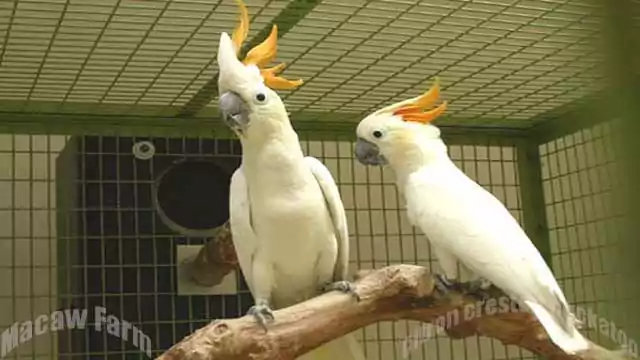Citron Crested Cockatoo Information for Your Family

Have you heard about, Citron Crested Cockatoo? They are a beautiful and uncommon parrot species that is highly appreciated for its colorful crest and engaging personality, you know. Them, originating from Indonesia, and this bird has won the hearts of avian enthusiasts worldwide, you are one of them, right?
In this article I am about to explore the Citron-Crested Cockatoo in detail and also going to cover its history, characteristics, care requirements, and more.
Introduction to the Citron-Crested Cockatoo
The Citron-Crested Cockatoo (Cacatua sulphurea citrinocristata) is a subspecies of the Lesser Sulphur-Crested Cockatoo, and which is actually native to the Indonesian islands of Sumba. This bird is remarkable for its bright yellow crest, which makes it so attractive among the species of the flock and the fact that besides being cute and funny, these species are well known for being affectionate and vividly1 intelligent ones.
Origins and Natural Habitat
Where Do They Come From?
- Citron-Crested Cockatoo, native to the island of Sumba in Indonesia and they inhabit tropical and subtropical forests, often found in the canopy of trees. Our living planet is one of the main deciding factors of this unique cockatoo’s extraordinary appearance and attitude.
The Current Conservation Status
- As a result of habitat loss and illegal trapping for the pet trade, the Citron-Crested Cockatoo is labeled critically endangered by the IUCN. Though conservation initiatives are in place, their numbers remain on a decline which makes caring for him/her and education towards this cause a very important part of life.
Physical Characteristics (Citron crested cockatoo)
Appearance
- Citron-Crested Cockatoo, around 13-15 inches long, and is medium-sized. The most remarkable feature is that the field of citron is very bright and vivid. It lifts the crest when it is excited or on top of it. White Tones of the main plume are evenly distributed across the rest of the body, with tinges of yellow caused by underwings and the tail.
Lifespan
- Normal lifespan of these birds can be up to 60 years or even longer if they are taken care of properly. But it also demands from potential owners a significant commitment.
Behavior and Personality (Citron crested cockatoo)
Intelligence and Social Nature
- Citron-Crested Cockatoos are extremely intelligent and sociable animals. They are really fond of interacting with their human friends and may become sick or develop behavior problems if they are neglected. But they are still the birds’ inquisitive and playful nature that also makes them engage in activities that stimulate their minds apart from playing.
Vocalizations
- These cockatoos do not produce the same amount of noise as bigger ones. Nevertheless, they are able to sing, squeal, and even speak human language. The vocal talent of these lovely birds is proof of intelligence capability but taming and socialization are necessary so as to avoid unnecessary noise.
Citron crested cockatoo Care Requirements
Diet
- Citron-Crested Cockatoos well-being is highly reliant on an optimal diet. A wide assortment of seeds, nuts, fresh fruits, and vegetables must be the diet of their staples. Premade bird food can also be fed to them to make sure they get all of the essential nutrients. Besides that, the water should always be replaced with fresh, clean water.
Housing
- The species of these avians need a big cage that offers them enough space to maneuver around and flap their wings freely. The birdcage should also be equipped with perches, toys, and foraging avenues to rouse their curiosity.
Grooming
- Citron-Crested Cockatoos need regular grooming to take care of nails, beaks, and feathers. Moreover, Bathing is one of the necessary procedures to maintain their feathers healthy. This can be achieved using a misting bottle or by allowing the bird to bathe in a shallow dish.
Health Concerns (Citron crested cockatoo)
Common Health Issues
- Like all parrots, Citron-Crested Cockatoos are susceptible to a few diseases such as psittacine beak and feather disease (PBFD), respiratory infections, and nutritional deficiencies. Regular vet visits are mandatory to address the health prompts at an early stage.
Signs of Illness
- Owners should be aware of the indicator symptoms of disease such as the change of appetite, feather plucking, lethargy, or respiratory problems for the sake of the bird’s health. Early diagnosis and intervention indicate a better condition of the bird’s health.
Breeding and Reproduction (Citron crested cockatoo)
Breeding in Captivity
- Breeding Citron-Crested Cockatoos in captivity: it requires both knowledge and experience. The new chicks usually appear in spring, and a healthy couple can lay between one and three eggs per clutch.
Ethical Considerations
- Because of the critical endangeredness of the species concerned, conservation should be undertaken with care and ethics. It is the duty of potential breeders to make sure that they do not only profit from the process but also contribute to the protection of the species.
The Legalities of Ownership (Citron crested cockatoo)
Legal Restrictions
- Because of their endangered condition the possession of such birds has become a subject of special regulations that apply in several countries. One is first to find out what are really local laws and regulations before such acquisition.
Responsible Ownership
- Owning a Citron-Crested Cockatoo is a significant responsibility. These birds require a high level of care, attention, and commitment. Prospective owners should thoroughly research and prepare before bringing one into their home.
Conclusion
The Citron-crested Cockatoo is a gorgeous yet smart bird that needs close supervision and loving care. With due care and the right treatment, these birds can be happy and lively with their owners for many years.
FAQs
How long do Citron-Crested Cockatoos live?
- If they’re well taken care of as they deserve to be, Citron-Crested Cockatoos can live up to 60 years and beyond even, hence this becomes a long-term companionship as well.
What do Citron-Crested Cockatoos eat?
- Their food should therefore include seeds, nuts, and of course fresh fruits and vegetables. A pellet-based food will also serve necessary nutritional requirements.
More pet bird species and more research
Umbrella Cockatoo
Thanks For Visit.








